Guide to call center benchmarking: Industry benchmarks and best practices

Director, Tier 1 Support and Development

Tags
Share
Your call center is a pivotal touchpoint between your business and your customers. It’s where customer satisfaction, brand loyalty, and operational efficiency all intersect, making its performance vital to success.
One way to ensure that every interaction is both efficient and effective is to measure performance against established standards—a practice known as benchmarking.
As a manager of a contact center here at Dialpad, we do some unique things when it comes to tracking and benchmarking performance, especially since our company builds AI tools specifically for customer-facing teams.
I’ll share some examples of how we do this below, along with some best practices when it comes to call center benchmarking, key metrics to consider, and more.
Understanding call center benchmarking
To run a successful call center, just tracking performance metrics isn't enough—you need to understand how your numbers compare to industry standards (even if you’re not necessarily at that level yet).
Call center benchmarking allows businesses to gauge their efficiency, customer satisfaction, and overall service quality against competitors and other best-in-class organizations. Whether you're focused on reducing wait times or lowering costs, these insights can help you refine strategies, improve agent productivity, and enhance the customer experience.
What is call center benchmarking?
Call center benchmarking involves comparing your call center's performance metrics against industry standards or best practices. This process is an essential part of call center optimization, and helps identify areas of strength and opportunities for improvement—for both agents and supervisors.
Why is it important?
Benchmarking is crucial for several reasons. Not only does it provide a clear picture of where your call center stands in relation to your competitors and overall industry standards, it also helps with goal-setting because it gives your managers a rough sense of realistic but ambitious performance targets.
Call center benchmarking can also make it easier to improve processes by highlighting inefficiencies—which ultimately keeps your customers happy too.
Types of benchmarking
There are a few ways to go about benchmarking your call center’s performance, like:
Internal benchmarking: Comparing performance metrics within different departments or teams in the same organization to identify best practices.
Competitive benchmarking: Evaluating your call center's performance against direct competitors to understand your market position.
Functional benchmarking: Comparing specific functions or processes with those of organizations known for excellence, regardless of industry.
Call center benchmarks by industry
Understanding and striving to meet industry benchmarks is vital for maintaining a competitive edge. Below are some call center KPIs (key performance indicators) that are commonly used across different industries—note that most of these can be looked at both from an agent-level and overall call center performance management perspective.
CSAT benchmarks
CSAT measures the percentage of customers who are very satisfied with their call center experience. According to The American Customer Satisfaction Index (ACSI), overall customer satisfaction in the US dropped slightly in the fourth quarter of 2024, down 0.8% to 77.3 on a scale of 1 to 100.
CSAT is also one of the more difficult metrics to benchmark because historically, not a lot of people actually fill out these surveys.
And usually only the angriest—and happiest—customers actually bother responding, which means your CSAT feedback is likely to be very skewed and not representative of how your customers feel overall. This makes it difficult to accurately benchmark against other competitors in your industry because you don’t know how representative their CSAT averages are.
Fun fact: Dialpad's industry-first AI CSAT feature is designed to solve this problem, by inferring CSAT scores for up to 100% of your customer calls thanks to its hyper-accurate transcription feature. The result: a much more representative sample size for CSAT scores, and a more accurate understanding of how satisfied your customers really are:
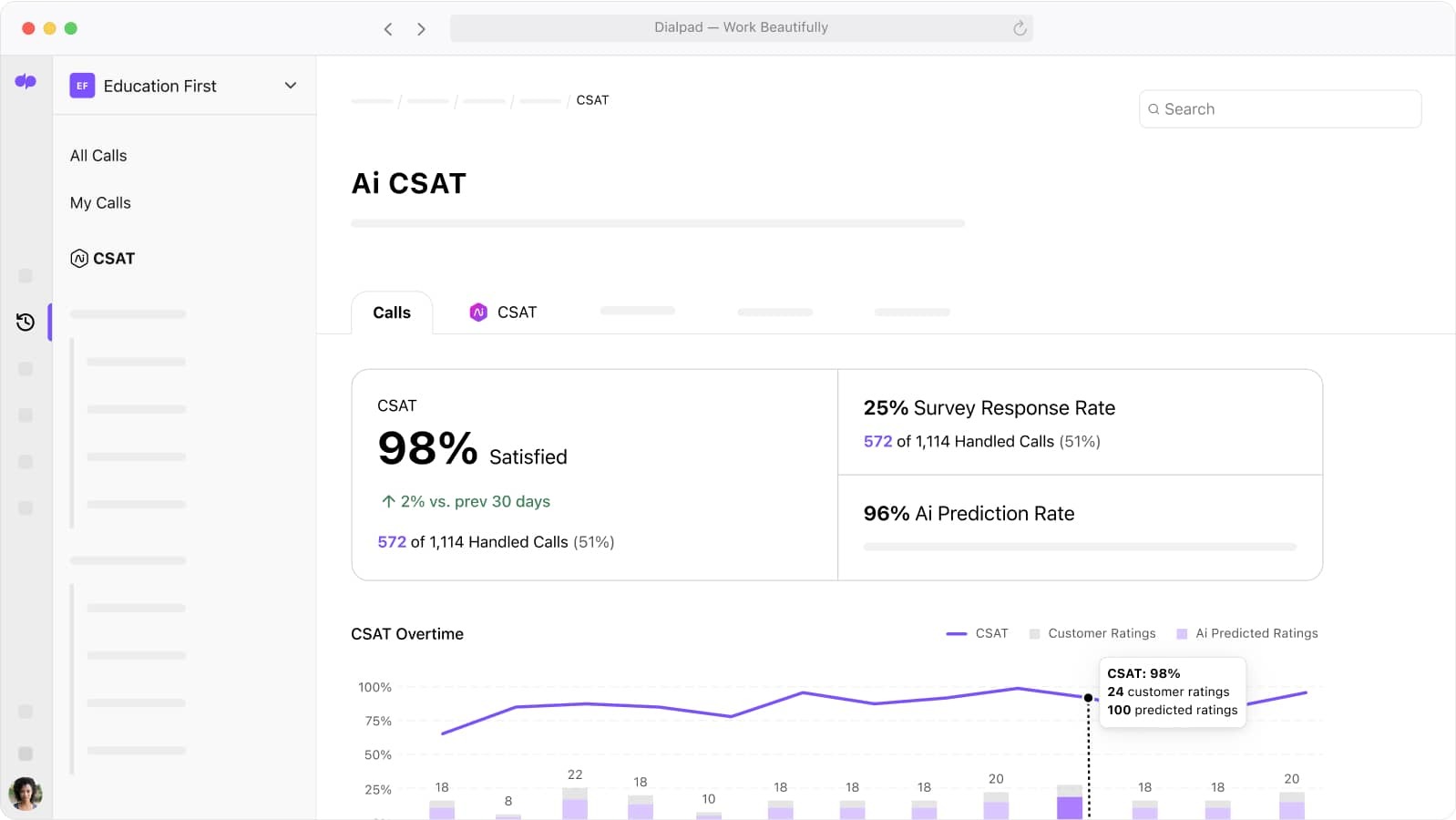
Call center NPS
NPS gauges customer loyalty by measuring the likelihood of customers recommending your services. While call center NPS benchmarks can vary widely across industries, a positive score indicates more promoters than detractors, signifying good performance. According to SurveyMonkey’s global benchmark data (they also broke down these call center performance benchmarks by industry), which accounts for the NPS of more than 150,000 organizations, the average score is +32.
Cost per contact
Cost per contact (CPC) tracks the average expense incurred for each call or message that’s handled by an agent, and gives you insights into operational efficiency and resource allocation. Lower CPC values are generally indicative of more cost-effective operations. According to Gartner, the median cost per contact is $1.84 for self-service and $13.50 for assisted channels.
Average speed of answer
ASA measures the average time it takes for calls or messages to be answered by an agent. According to Call Centre Helper, the global average for ASA is 28 seconds.
Agent utilization
Agent utilization is the percentage of time that agents spend handling customer conversations versus their total available time. According to MetricNet, the average agent utilization rate is about 48%—and even though call center productivity is important, don’t make the mistake of trying to hit 100% utilization. “Whenever agent utilization rates approach 60–70 percent, a service desk will experience relatively high agent turnover because they are pushing the agents too hard, leading to burnout and low morale.”
Call center abandon rate
This metric indicates the percentage of callers who hang up before reaching an agent. Lower abandon rates are better, since higher abandon rates may mean your wait times are too long or your call center is understaffed. Generally, you’ll see anywhere from five to 10 percent cited as an acceptable abandon rate, and it also depends on your industry, so you might find it more productive to measure improvements against your own past performance.
Call center attrition
Attrition measures the rate at which agents leave your call center over a specific time period. High attrition rates lead to increased recruitment and training costs and also impact your service quality. According to the SQM Group, the agent turnover rate was at a historic high in 2023 at 38%—but keep in mind that call center attrition benchmarks can vary by industry, company size, and the specific role or function of the agents, with factors such as job complexity, compensation, and work environment influencing turnover rates.
Average resolution time
This KPI tracks the average time taken to resolve your customers’ issues. The shorter the resolution time, the better. Average resolution times can vary significantly between industries, and currently there aren’t many solid research-backed benchmarks (that I’ve seen, anyway), so again you might be better off measuring against past performance here.
Also, note that you may have different targets depending on which customers you serve. For example, if you’re at a SaaS company and serve both small businesses and enterprises, you might find that enterprises have more complicated issues that require more time to resolve. This may lead you to decide to have one resolution time target for SMBs, and another more generous target for agents serving enterprise customers.
Call center benchmarking best practices
Setting and maintaining effective benchmarks is key to running a high-performing call center. Try to avoid simply adopting industry standards as targets without considering your specific business context—this almost always leads to unrealistic goals (and missed opportunities for improvement).
To effectively implement benchmarking in your call center, consider these best practices:
1. Set realistic goals
Establish achievable targets based on industry benchmarks and your call center's current performance. Unrealistic goals can demotivate staff and hinder progress. Start by analyzing your own historical data to set incremental goals, like reducing average call handling time by 5% over six months.
2. Regularly review and adjust benchmarks
Continuously monitor performance metrics and adjust your benchmarks as needed to reflect changes in business objectives, customer expectations, and industry trends.
Use some of your quarterly performance review time with agents to assess progress and recalibrate benchmarks based on customer needs and/or your competitive landscape.
3. Leverage analytics dashboards
Use analytics tools to collect and analyze performance data. Ideally, your contact center platform should come with real-time dashboards that display key metrics like call resolution rates and customer satisfaction scores, which will help supervisors make adjustments quickly.
For example, Dialpad Support has built-in heatmaps that show which times of day are busiest, both in terms of call volume and average speed of answer:
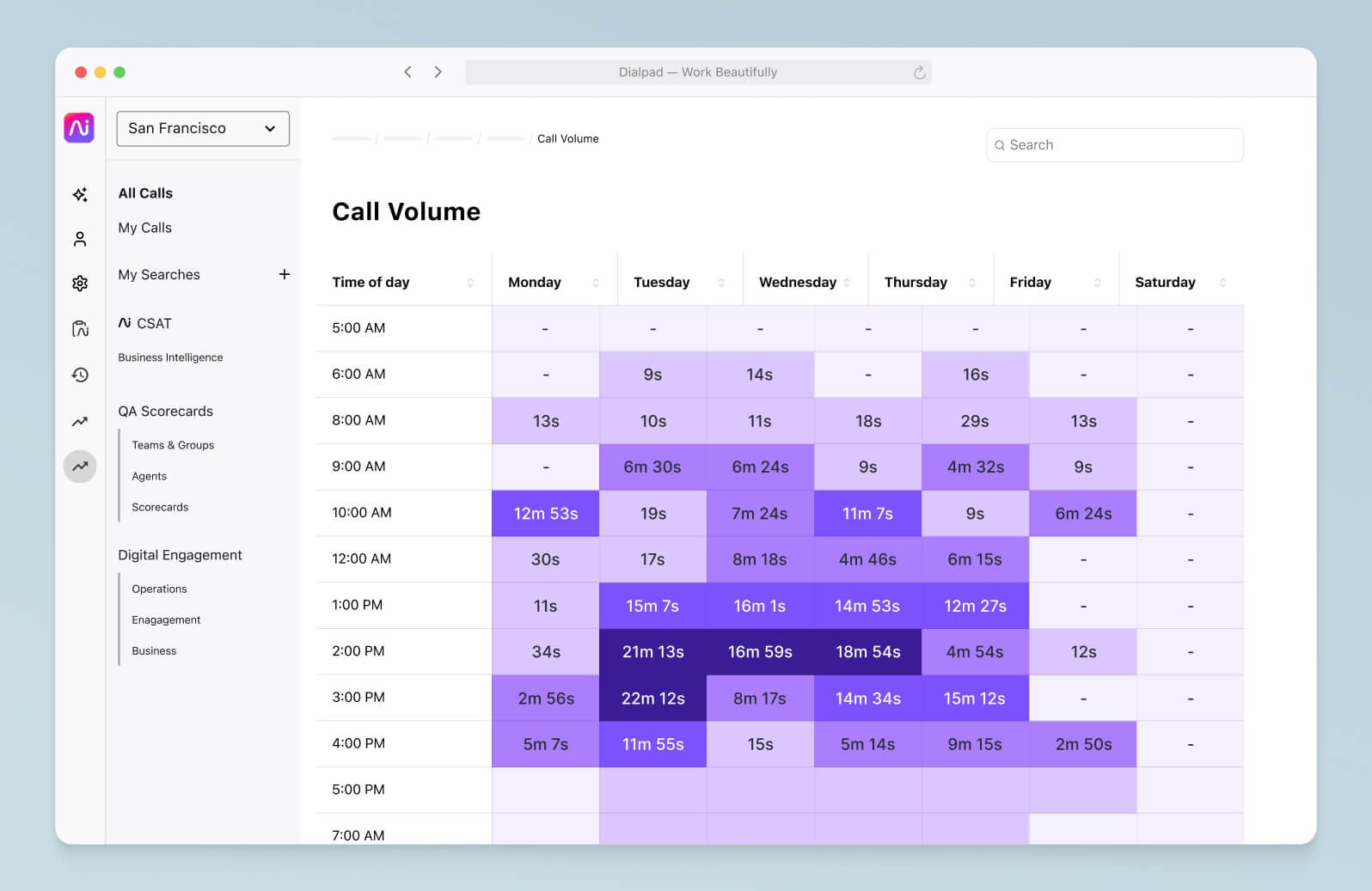
How to overcome common benchmarking challenges
Benchmarking can present several challenges. Here’s how to address them:
Maintaining data consistency
One of the biggest challenges in benchmarking is ensuring that performance data is accurate and comparable across different teams, departments, and channels. Inconsistencies in data collection methods, inconsistent reporting structures, and human error can create discrepancies that distort benchmarking results, making it difficult to track progress or make informed decisions.
To address this, create clear guidelines for data entry, categorization, and reporting to minimize discrepancies between teams.
Use automation tools and AI-driven analytics to track key metrics in real time and reduce the risk of human error. One of the reasons we love using Dialpad’s contact center platform is because we can see all the analytics we need in a single place without having to toggle back and forth between different apps.
Incoming calls, abandoned calls, ASA, AI CSAT—we can see it in a single pane of glass in Dialpad Support:
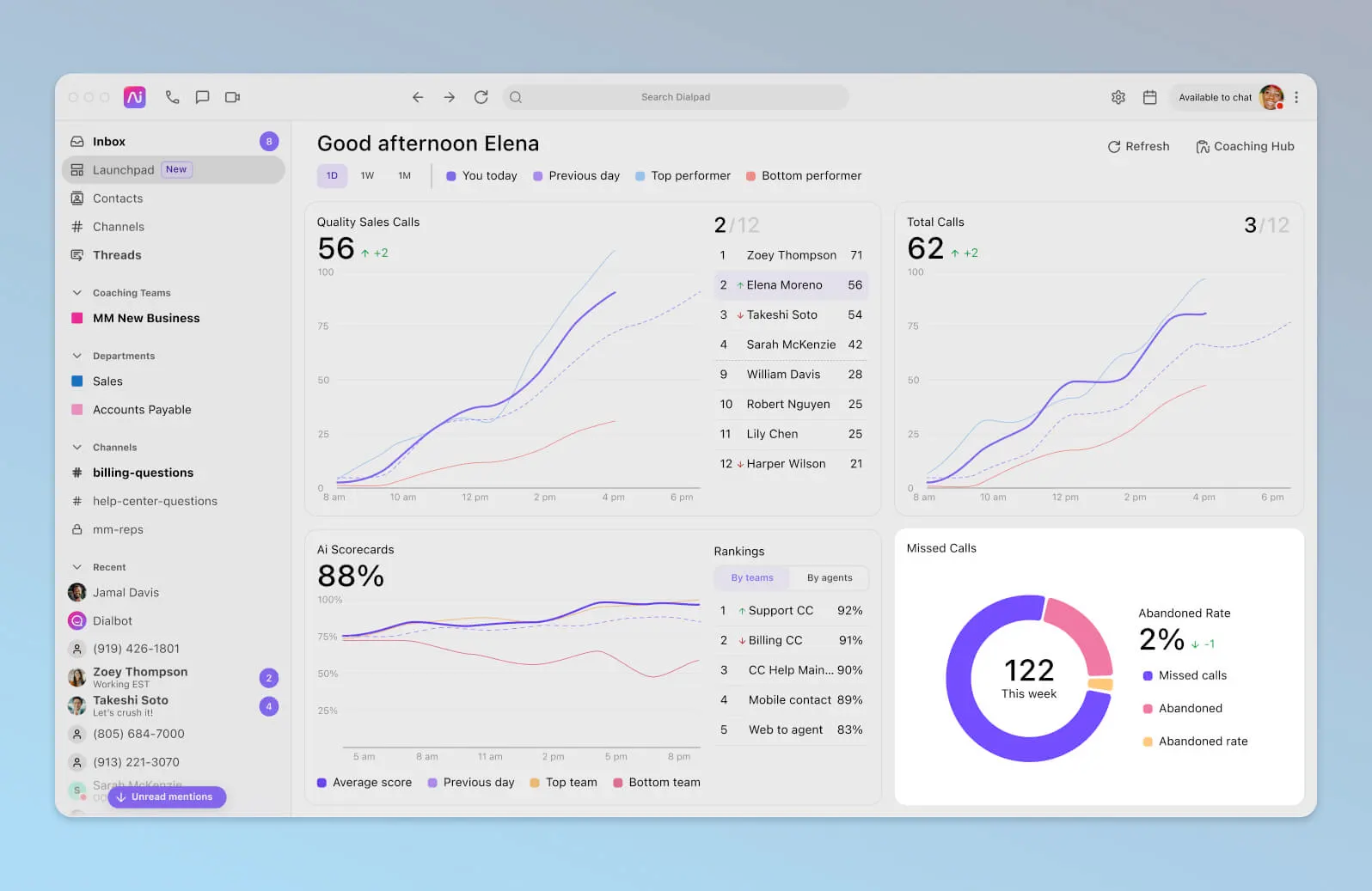
Translating data into actionable insights
Collecting benchmarking data is just the first step—the real challenge is making sense of it and using it to drive meaningful change. Many call centers struggle to extract meaningful insights from their data, and to overcome this, you can start by segmenting data by agent performance, call type, and customer demographics to pinpoint specific areas that need improvement.
AI can be super helpful here because it can analyze huge volumes of data in way less time than a human can. For example, instead of our supervisors having to listen to every single call recording, Dialpad AI can track how often certain keywords are spoken on calls. Say we want to know how many customers are calling to cancel or get a refund. We can create “Custom Moments” to track words like “cancel” and “refund”—if we notice any spikes or anomalies, then we can dig into the transcripts and recordings to get more context:
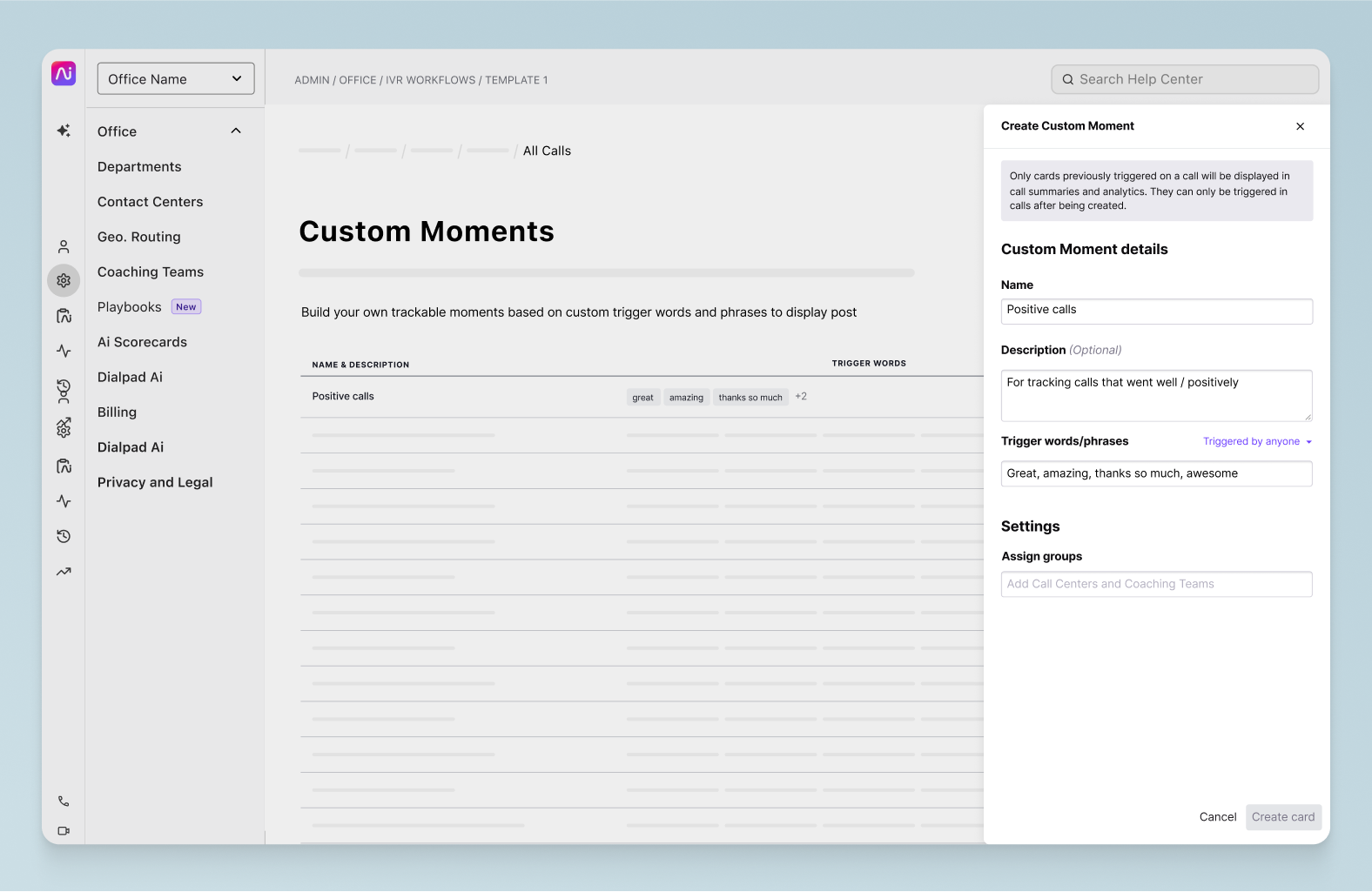
This saves hours in call review time—every week.
Resource allocation and management
Even when benchmarks highlight areas that need improvement, limited resources can make it hard to implement necessary changes. Budget constraints, staffing shortages, and inefficient workload distribution can all prevent call centers from achieving their performance goals.
To tackle this, assess workload distribution and use workforce management software to optimize agent scheduling and shift planning. We use Dialpad’s WFM features to help with this, since it can auto-schedule shifts fairly across the contact center:
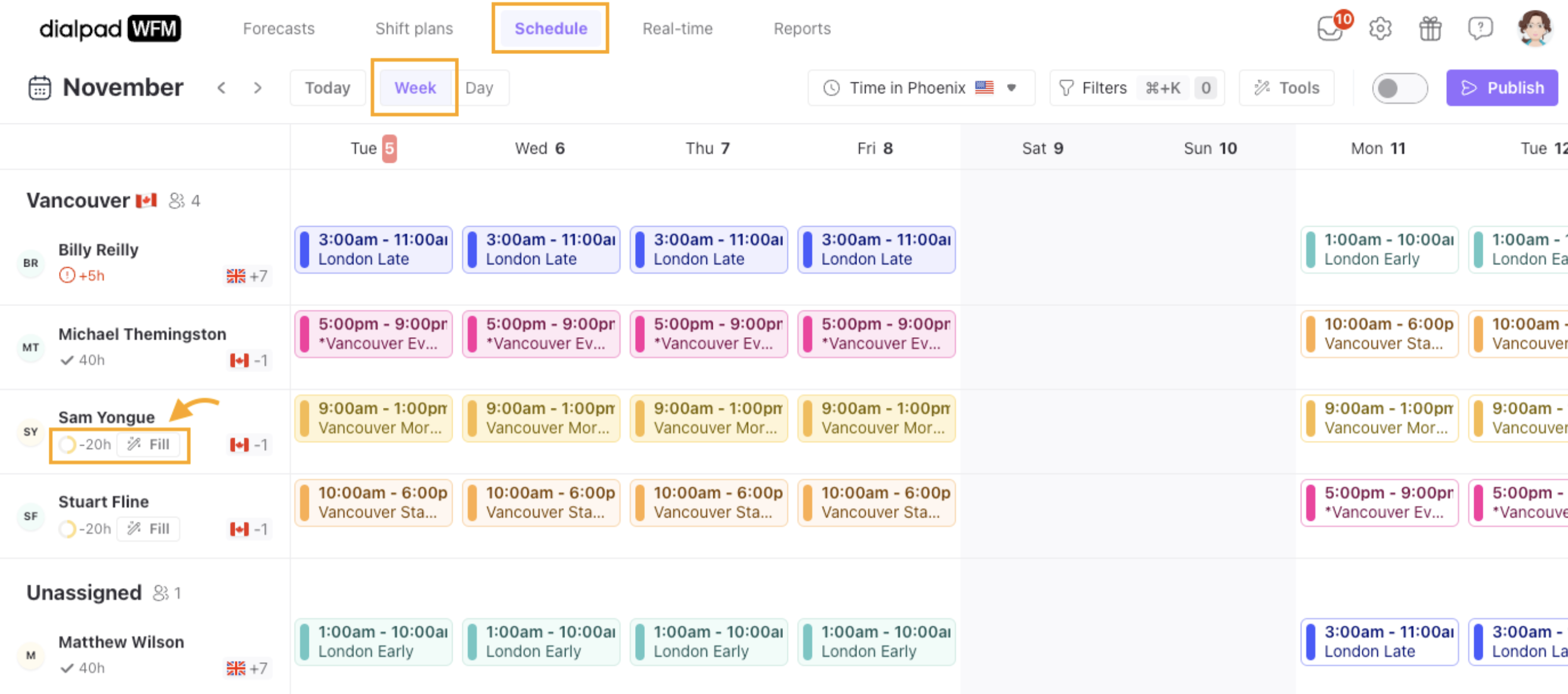
You could also invest in ongoing training and upskilling programs to help ensure your agents have the necessary skills to meet their performance targets.
Sometimes, this might mean offloading low-value tasks like basic account inquiries, password resets, or order tracking to automated systems. By leveraging self-service options like chatbots and knowledge bases, you can help customers get routine questions answered quickly and accurately without tying up agents.
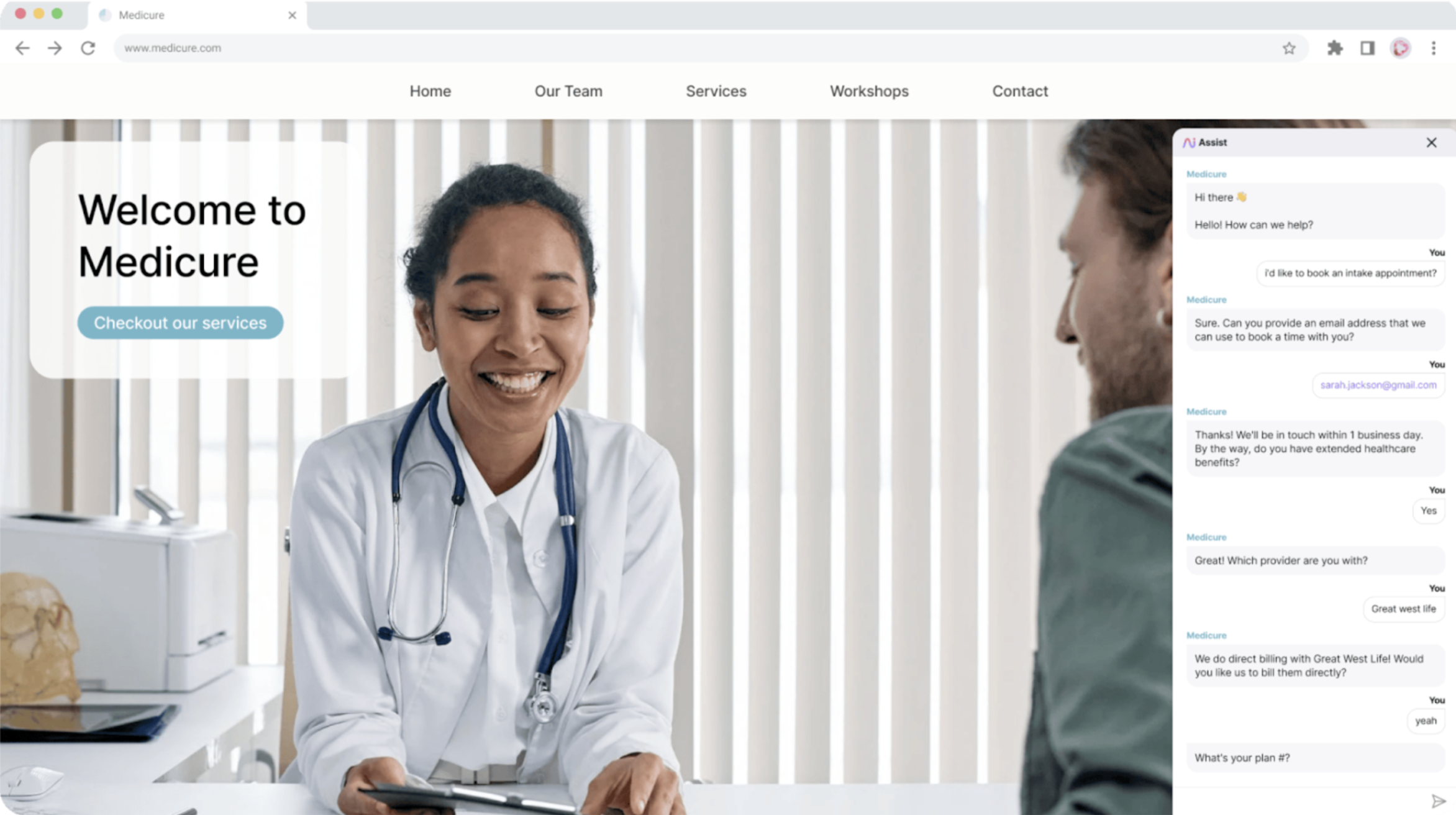
This frees up agents to focus on more complex issues like resolving escalated problems, providing personalized support, or handling high-priority customer concerns, which ultimately improves both agent productivity and the customer experience.
Improve call center performance with Dialpad Support
Contact center benchmarking is a powerful tool for businesses that want to improve their performance and customer satisfaction, but it’s not a silver bullet.
Even though benchmarking provides valuable insights into how your call center compares to industry standards, you still need to understand how your key metrics reflect the unique strengths and weaknesses in your operations.
Learn more about how companies like RE/MAX and Randstad are using Dialpad Support to improve their contact center performance!
Not hitting your contact center benchmarks?
Dialpad’s unique AI-powered tools are designed to help contact center teams get more conversational insights out of the conversations they’re already having—every day—with robust built-in analytics dashboards. See how it works with a demo, or take a self-guided interactive tour of the app first!
